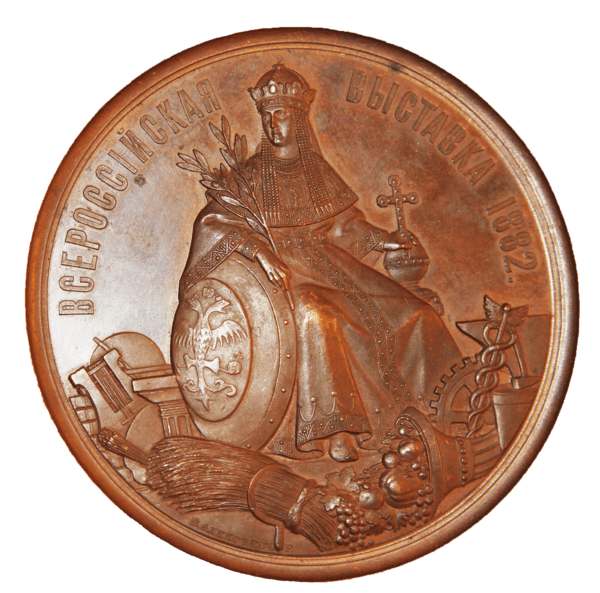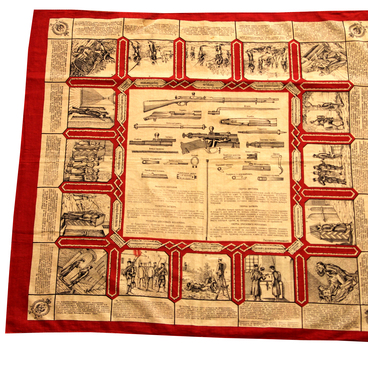The Medal in memory of the All-Russian Exhibition was released in 1882. It became part of the museum’s collection in the 1920s when it was brought from the museum of the Kaluga Scientific Archival Commission. Specialists were unable to identify its owner.
The long-awaited All-Russian Exhibition in Moscow was organized only 12 years after 1870, when it was held in St. Petersburg. Its date was postponed several times. At first, because of Russia’s careful and long preparation for the upcoming exhibitions in the United States and France, in which it took part, and later because of the attempted assassination of Emperor Alexander II in 1881.
Finally, the exhibition opened on May 20, 1882 in Khodynka Field. It worked for 131 days and was attended by more than a million people despite the fee charged for admission. The Paris Revue de Deux Mondes (Review of the Two Worlds) wrote: The 1882 Exhibition is a real triumph for industrial Russia, it is as an expression of tremendous progress in all areas of human labor over the past ten years.
The exhibition pavilions were each decorated in individual styles and sometimes looked very extraordinary. For example, the vodka stand presented by Striedter, a supplier of the imperial court, was made of bottles in the form of a triumphal arch. The exposition of the Zlatoust Arms Factory was decorated with the Russian coat of arms made of sabers and cockades. The St. Petersburg branch of Siemens & Halske built a real electric railway in the territory of the exhibition, which was the first one in Russia, while Brocard & Co, a perfumes producer, surprised visitors with a cologne fountain.
Researchers know a few names of Kaluga merchants who took part in the 1882 exhibition. Sergey Maltsov presented cast iron stoves, enameled utensils and furniture, while Dmitry Goncharov, the owner of the Polotnyany Zavod estate, presented various types of paper: letter, tea, newsprint, and tissue paper.
Commemorative medals were made for visitors at the exhibition with a coinage machine. An octagon was cut out of a metal plate in front of the public with a round shape forged from it. Then, it was calcined, cleaned and put under a press. After eight presses on a special screw and heat treatment, the medal was ready.
The long-awaited All-Russian Exhibition in Moscow was organized only 12 years after 1870, when it was held in St. Petersburg. Its date was postponed several times. At first, because of Russia’s careful and long preparation for the upcoming exhibitions in the United States and France, in which it took part, and later because of the attempted assassination of Emperor Alexander II in 1881.
Finally, the exhibition opened on May 20, 1882 in Khodynka Field. It worked for 131 days and was attended by more than a million people despite the fee charged for admission. The Paris Revue de Deux Mondes (Review of the Two Worlds) wrote: The 1882 Exhibition is a real triumph for industrial Russia, it is as an expression of tremendous progress in all areas of human labor over the past ten years.
The exhibition pavilions were each decorated in individual styles and sometimes looked very extraordinary. For example, the vodka stand presented by Striedter, a supplier of the imperial court, was made of bottles in the form of a triumphal arch. The exposition of the Zlatoust Arms Factory was decorated with the Russian coat of arms made of sabers and cockades. The St. Petersburg branch of Siemens & Halske built a real electric railway in the territory of the exhibition, which was the first one in Russia, while Brocard & Co, a perfumes producer, surprised visitors with a cologne fountain.
Researchers know a few names of Kaluga merchants who took part in the 1882 exhibition. Sergey Maltsov presented cast iron stoves, enameled utensils and furniture, while Dmitry Goncharov, the owner of the Polotnyany Zavod estate, presented various types of paper: letter, tea, newsprint, and tissue paper.
Commemorative medals were made for visitors at the exhibition with a coinage machine. An octagon was cut out of a metal plate in front of the public with a round shape forged from it. Then, it was calcined, cleaned and put under a press. After eight presses on a special screw and heat treatment, the medal was ready.



